The football boot has evolved from a piece of protective footwear in it’s 1800’s inception to a way of increasing performance in the modern game. The number of manufacturers, styles, colours and brands have increased dramatically in recent times, as the modern day footballer’s footwear is idolised by adoring fans and supporters. Here is just how much the game’s footwear has evolved as the sport has progressed.
- The earliest football boots recorded were that of King Henry VIII in 1526, however little is known about the boot.
- The game in Britain really took of in the late 1800’s, with many of the famous football clubs that compete in the Premier League today founded in 1880’s or 90’s. The first ever boots were developed with steel toecaps and were more to shield the competitor from abrasive tackles than to help with play.
- Early boots also had long laces and ankle supports, with large metal studs attached to the sole. Early football boots were made out of heavy leather, and weighed around 500g; this could get up to 1kg when the footwear was wet.
- Between 1900 and 1940 there was little progression in the development of football boots, with Gola, Hummel and Valsport the main suppliers of the footwear.
- After the Second World War, technique and performance started to come into the design of boots. The South Americans initially developed a lighter boot to aid mobility and control.
In 1954 Adolf Dassler, along with brother Rudolf, developed the first boot with removable studs. This helped to improved speed whilst running, and made sudden movements more easy. Adi formed Adidas (Adi Dassler), whilst after a fallout, Rudolf went on to form Puma.
- Mitre, Asics and Joma were all started in the 1960’s, and the style of boot changed from an ankle support to a lower cut if boot that is seen today. This change in shape again allowed for increased movement and became more comfortable for the players of the game.
- The 1970’s saw the first boots that were not merely black, with footwear of different colours introduced. Adidas established itself as a market leader, and developed the Copa Mundial in the late 1970’s, which is still an icon of football boots in the modern game.
- Australian Craig Johnston, a former player for Middlesbrough and Liverpool, developed the Adidas Predator boot in the 1980’s, which was later released in 1994. It is to this day the most famous football boot. In the late 1980’s Umbro were formed also.
- The 1990’s saw different, lighter soles incorporated into boots to aid the players’ balance. Reebok and Mizuno entered the market and immediately made an impact.
- American sports equipment producer Nike entered the football boots market in the 1990’s, and created the lightest boot recorded at the time in 1998; the Nike Mercurial weighed only 200g.
- Despite the market being dominated by Adidas, Nike and Puma since the turn of the century, smaller vendors such as Mizuno, Diadora, Kelme and Lotto have all been able to operate, and have contributed to the advancement of the footwear.
- Nomis created a boot with Wet Control Technology in 2002, Shark Technology was introduced by Kelme in 2006 and a lace-less boot was also incorporated by Lotto in 2006.
- Laser Technology has meant that boots can be customised for specific players, and is perhaps the most innovative development of modern times, as most leading players have tailor-made footwear.
- Current three-times Ballon d’Or winner Lionel Messi is the face of Adidas’ new f50 boot, which is the first boot to include computer technology. A miCoach Speed Cell chip is included in the sole to measure attributes such as speed and distance. This technology is incorporated with the idea of measuring performance after games.
Add Sportslens to your Google News Feed!

 In 1954 Adolf Dassler, along with brother Rudolf, developed the first boot with removable studs. This helped to improved speed whilst running, and made sudden movements more easy. Adi formed Adidas (Adi Dassler), whilst after a fallout, Rudolf went on to form Puma.
In 1954 Adolf Dassler, along with brother Rudolf, developed the first boot with removable studs. This helped to improved speed whilst running, and made sudden movements more easy. Adi formed Adidas (Adi Dassler), whilst after a fallout, Rudolf went on to form Puma.